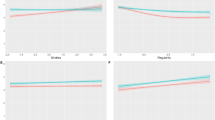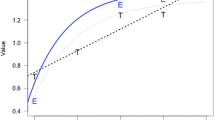Abstract
Recent research has shown that the visual complexity of orthographies across writing systems influences the development of orthographic representations. Simplified and traditional Chinese characters are usually regarded as the most visually complicated writing systems currently in use, with the traditional system showing a higher level of complexity. However, it is still unclear whether and how learning two Chinese writing systems influences the processing of characters among simplified and traditional Chinese script readers. This study employed the categorical perception (CP) paradigm to examine adult Mainland China Chinese (MLC) simplified character readers and adult Hong Kong Chinese (HKC) traditional character readers’ liminal perception of the following types of morphing continua of “line characters” (with font features removed): the Absolute-Differentiation (AD) type, which contains a topological change, and the Relative-Differentiation type, which does not contain any topological change in visual configurations. The results showed evidence of CP effects on the two types of stimuli among MLC and HKC readers. Moreover, MLC and HKC readers presented major differences in perceiving AD-type stimuli, indicating that different experiences with two Chinese writing systems influence character perception. These findings extend previous results regarding the comparison of visual skills of simplified and traditional Chinese script readers and support the hypothesis that simplified Chinese script readers have higher visual discrimination rates than do traditional Chinese script readers in character perception.









Similar content being viewed by others
References
Abdelhadi, S., Ibrahim, R., & Eviatar, Z. (2011). Perceptual load in the reading of Arabic: Effects of orthographic visual complexity on detection. Writing Systems Research, 3(2), 117–127. https://doi.org/10.1093/wsr/wsr014.
Abramson, A. S. (1979). The noncategorical perception of tone categories in Thai. In B. Lindblom & S. Öhman (Eds.), Frontiers of Speech Communication Research (pp. 127–134). London: Academic Press.
Ai, W. (1955). Some Issues in Chinese Characters [漢字問題]. Taipei [台北]: National Publishing House [國立編譯館] (Written in Chinese).
Beale, J. M., & Keil, F. C. (1995). Categorical effects in the perception of faces. Cognition, 57(3), 217–239. https://doi.org/10.1016/0010-0277(95)00669-x.
Chang, L.-Y., Plaut, D. C., & Perfetti, C. A. (2016). Visual complexity in orthographic learning: Modeling learning across writing system variations. Scientific Studies of Reading, 20(1), 64–85. https://doi.org/10.1080/10888438.2015.1104688.
Chen, L. (1982). Topological structure in visual perception. Science, 218(4573), 699–700. https://doi.org/10.1126/science.7134969.
Chen, L. (1985). Topological structure in the perception of apparent motion. Perception, 14(2), 197–208. https://doi.org/10.1068/p140197.
Chen, L. (2005). The topological approach to perceptual organization. Visual Cognition, 12(4), 553–637. https://doi.org/10.1080/13506280444000256.
Chen, L., Zhang, S., & Srinivasan, M. V. (2003). Global perception in small brains: Topological pattern recognition in honey bees. Proceedings of the National Academy of Sciences of America, 100(11), 6884–6889. https://doi.org/10.1073/pnas.0732090100.
Chen, M. J., & Yuen, J. C.-K. (1991). Effects of pinyin and script type on verbal processing: Comparisons of China, Taiwan, and Hong Kong experience. International Journal of Behavioral Development, 14(4), 429–448. https://doi.org/10.1177/016502549101400405.
Chen, X., & Kao, H. S. R. (2002). Visual-spatial properties and orthographic processing of Chinese characters. In H. S. R. Kao (Ed.), Cognitive Neuroscience Studies of the Chinese Language (pp. 175–194). Hong Kong: Hong Kong University Press.
Chen, Y.-P., Allport, A. D., & Marshall, J. C. (1996). What are the functional orthographic units in Chinese word recognition: The stroke or the stroke pattern? The Quarterly Journal of Experimental Psychology Section A, 49(4), 1024–1043. https://doi.org/10.1080/713755668.
Cheung, H., & Ng, L. K. H. (2003). Chinese reading development in some major Chinese societies: An introduction. In C. McBride-Chang & H. C. Chen (Eds.), Reading Development in Chinese Children (pp. 3–18). Westport, CT: Praeger.
Dehaene, S., Cohen, L., Morais, J., & Kolinsky, R. (2015). Illiterate to literate: Behavioural and cerebral changes induced by reading acquisition. Nature Review Neuroscience, 16(4), 234–244. https://doi.org/10.1038/nrn3924.
Dehaene, S., Pegado, F., Braga, L. W., Ventura, P., Filho, G. N., Jobert, A., et al. (2010). How learning to read changes the cortical networks for vision and language. Science, 330(6009), 1359–1364. https://doi.org/10.1126/science.1194140.
Etcoff, N. L., & Magee, J. J. (1992). Categorical perception of facial expressions. Cognition, 44(3), 227–240. https://doi.org/10.1016/0010-0277(92)90002-y.
Francis, A. L., Ciocca, V., & Ng, B. K. C. (2003). On the (non)categorical perception of lexical tones. Perception and Psychophysics, 65(7), 1029–1044. https://doi.org/10.3758/bf03194832.
Fry, D. B., Abramson, A. S., Eimas, P. D., & Liberman, A. M. (1962). The identification and discrimination of synthetic vowels. Language and Speech, 5(4), 171–189. https://doi.org/10.1177/002383096200500401.
Gao, D.-G., & Kao, H. S. R. (2002). Psycho-geometric analysis of commonly used Chinese characters. In H. S. R. Kao (Ed.), Cognitive Neuroscience Studies of the Chinese Language (pp. 195–206). Hong Kong: Hong Kong University Press.
Gilbert, A. L., Regier, T., Kay, P., & Ivry, R. B. (2006). Whorf hypothesis is supported in the right visual field but not the left. Proceedings of the National Academy of Sciences, 103(2), 489–494. https://doi.org/10.1073/pnas.0509868103.
Goldstone, R. L., & Hendrickson, A. T. (2010). Categorical perception. Wiley Interdisciplinary Reviews: Cognitive Science, 1(1), 69–78. https://doi.org/10.1002/wcs.26.
Hallé, P. A., Chang, Y.-C., & Best, C. T. (2004). Identification and discrimination of Mandarin Chinese tones by Mandarin Chinese vs. French listeners. Journal of Phonetics, 32(3), 395–421. https://doi.org/10.1016/s0095-4470(03)00016-0.
Harnad, S. R. (1987). Introduction: Psychological and cognitive aspects of categorical perception: A critical overview. In S. R. Harnad (Ed.), Categorical Perception: The Groundwork of Cognition (pp. 1–25). Cambridge: Cambridge University Press.
Ho, H.-H., & Kwan, T.-W. (2001). Hong Kong, Mainland China and Taiwan: Chinese Character Frequency-A Tans-Regional, Diachronic Survey. http://humanum.arts.cuhk.edu.hk/Lexis/chifreq/. Accessed 4 Nov 2017.
Hoosain, R. (1991). Psycholinguistic Implications for Linguistic Relativity: A Case Study of Chinese. Hillsdale, NJ: Erlbaum.
Jones, J. (2009). Sqirlz Morph (Version 2.1). Retrieved from http://www.xiberpix.net/SqirlzMorph.html. Accessed 6 Dec 2012.
Kao, H. S. R. (2000). The visual-spatial properties of Chinese characters and psycho-geometric theory of Chinese character writing [漢字視覺空間特徵與漢字書寫的心理幾何理論]. In H. S. R. Kao (Ed.), Chinese Calligraphy Therapy [書法心理治療] (pp. 3–41). Hong Kong [香港]: Hong Kong University Press [香港大學出版社] (Written in Chinese).
Liberman, A. M., Harris, K. S., Hoffman, H. S., & Griffith, B. C. (1957). The discrimination of speech sounds within and across phoneme boundaries. Journal of Experimental Psychology, 54(5), 358–368. https://doi.org/10.1037/h0044417.
Liu, L. (1993). Analysis of the topological structures of Chinese characters [漢字拓撲結構分析]. In Y. Chen (Ed.), Information Analysis of the Usage of Characters in Modern Chinese [現代漢語用字信息分析] (pp. 15–32). Shanghai [中國上海]: Shanghai Education Publisher [上海教育出版社] (Written in Chinese).
McBride, C. (2004). Children’s Literacy Development. New York: Routledge.
McBride, C. (2015). Is Chinese special? Four aspects of Chinese literacy acquisition that might distinguish learning Chinese from learning alphabetic orthographies. Educational Psychology Review, 28, 523–549. https://doi.org/10.1007/s10648-015-9318-2.
McBride, C. (2016). Children’s Literacy Development: A Cross-Cultural Perspective on Learning to Read and Write (2nd ed.). New York: Routledge.
McBride, C., Chow, B. W. Y., Zhong, Y., Burgess, S., & Hayward, W. G. (2005). Chinese character acquisition and visual skills in two Chinese scripts. Reading and Writing, 18(2), 99–128. https://doi.org/10.1007/s11145-004-7343-5.
McBride, C., & Wang, Y. (2015). Learning to read Chinese: Universal and unique cognitive cores. Child Development Perspectives, 9, 196–200. https://doi.org/10.1111/cdep.12132.
McBride, C., Zhou, Y., Cho, J.-R., Aram, D., Levin, I., & Tolchinsky, L. (2011). Visual spatial skill: A consequence of learning to read? Journal of Experimental Child Psychology, 109(2), 256–262. https://doi.org/10.1016/j.jecp.2010.12.003.
Oldfield, R. C. (1971). The assessment and analysis of handedness: The Edinburgh inventory. Neuropsychologia, 9(1), 97–113. https://doi.org/10.1016/0028-3932(71)90067-4.
Pastore, R. E. (1987). Categorical perception: Some psychophysical models. In S. R. Harnad (Ed.), Categorical Perception: The Groundwork of Cognition (pp. 29–52). Cambridge: Cambridge University Press.
Peng, G., Minett, J. W., & Wang, W. S.-Y. (2010a). Cultural background influences the liminal perception of Chinese characters: An ERP study. Journal of Neurolinguistics, 23(4), 416–426. https://doi.org/10.1016/j.jneuroling.2010.03.004.
Peng, G., Zheng, H.-Y., Gong, T., Yang, R.-X., Kong, J.-P., & Wang, W. S.-Y. (2010b). The influence of language experience on categorical perception of pitch contours. Journal of Phonetics, 38(4), 616–624. https://doi.org/10.1016/j.wocn.2010.09.003.
Pisoni, D. B. (1975). Auditory short-term memory and vowel perception. Memory & Cognition, 3(1), 7–18. https://doi.org/10.3758/BF03198202.
Taft, M. (2006). Processing of characters by native Chinese readers. In P. Li, E. Bates, L. H. Tan, & O. J. L. Tzeng (Eds.), The Handbook of East Asian Psycholinguistics (1st ed., Vol. 1, pp. 237–249). Cambridge: Cambridge University Press.
Tamaoka, K., & Kiyama, S. (2013). The effects of visual complexity for Japanese kanji processing with high and low frequencies. Reading and Writing, 26(2), 205–223. https://doi.org/10.1007/s11145-012-9363-x.
Tan, L. H., Spinks, J. A., Eden, G. F., Perfetti, C. A., & Siok, W. T. (2005). Reading depends on writing, in Chinese. Proceedings of the National Academy of Sciences, 102(24), 8781–8785. https://doi.org/10.1073/pnas.0503523102.
Todd, J. T., Chen, L., & Norman, J. F. (1998). On the relative salience of Euclidean, affine, and topological structure for 3-D form discrimination. Perception, 27(3), 273–282. https://doi.org/10.1068/p270273.
Tzeng, O. J. L., & Wang, W. S.-Y. (1983). The first two R’s: The way different languages reduce speech to script affects how visual information is processed in the brain. American Scientist, 71(3), 238–243. https://doi.org/10.2307/27852010.
Wang, H. (Ed.) (1995). A Practical Dictionary on Simplified Sinograms with Similar Configurations [實用形近字字典]. Beijing [中國北京]: Academy Press [學苑出版社] (Written in Chinese).
Wang, W. S.-Y. (1976). Language change. In S. R. Harnad, H. D. Steklis, & J. Lancaster (Eds.), Origins and Evolution of Language and Speech (Annals of the New York Academy of Sciences) (Vol. 280, pp. 61–72). New York: New York Academy of Sciences.
Wang, W. S.-Y., & Tsai, Y. (2011). The alphabet and the sinogram. In P. McCardle, B. Miller, J. R. Lee, & O. J. L. Tzeng (Eds.), Dyslexia Across Languages, Orthography and the Brain-Gene-Behavior Link (pp. 1–31). Baltimore, MD: Paul H. Brookes Publishing Co.
Xu, Y., Gandour, J. T., & Francis, A. L. (2006). Effects of language experience and stimulus complexity on the categorical perception of pitch direction. The Journal of the Acoustical Society of America, 120(2), 1063–1074. https://doi.org/10.1121/1.2213572.
Yasuhara, M., & Kuklinski, T. (1978). Category boundary effect for grapheme perception. Perception and Psychophysics, 23(2), 97–104. https://doi.org/10.3758/bf03208288.
Zhang, J., & McBride, C. (2011). Diversity in Chinese literacy acquisition. Writing Systems Research, 3(1), 87–102. https://doi.org/10.1093/wsr/wsr011.
Zhang, Y. (2016). Categorical perception. In R. Sybesma, W. Behr, Y. Gu, Z. Handel, J. C.-T. Huang, & J. Myers (Eds.), Encyclopedia of Chinese Language and Linguistics (1st ed.). Brill: Leiden. https://doi.org/10.1163/2210-7363_ecll_COM_000071.
Zheng, H.-Y., Minett, J. W., Peng, G., & Wang, W. S.-Y. (2011). The impact of tone systems on the categorical perception of lexical tones: An event-related potentials study. Language and Cognitive Processes, 27(2), 184–209. https://doi.org/10.1080/01690965.2010.520493.
Acknowledgements
This study was partially supported by the General Research Fund of the Hong Kong Special Administrative Region Research Grants Council, awarded to Prof. William Shi Yuan Wang (Project No. 14611615). The authors thank all the participants. The authors also acknowledge the editor and reviewers for their constructive help in improving the paper. The first author also thanks Dr. James W. Minett for his insightful comments in the early stage of this study.
Funding
Funding was provided by General Research Fund of the Hong Kong Special Administrative Region Research Grants Council (Grant No. 14611615).
Author information
Authors and Affiliations
Corresponding author
Rights and permissions
About this article
Cite this article
Yang, R., Wang, W.S.Y. Categorical perception of Chinese characters by simplified and traditional Chinese readers. Read Writ 31, 1133–1154 (2018). https://doi.org/10.1007/s11145-018-9832-y
Published:
Issue Date:
DOI: https://doi.org/10.1007/s11145-018-9832-y




